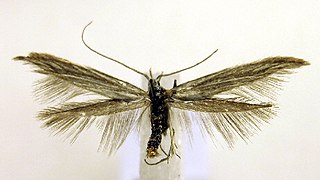
The Coleophoridae are a family of small moths, belonging to the huge superfamily Gelechioidea. Collectively known as case-bearers, casebearing moths or case moths, this family is represented on all continents, but the majority are found in temperate areas of the Northern Hemisphere. They are most common in the Palearctic, and rare in sub-Saharan Africa, South America, and Australia; consequently, they probably originated in northern Eurasia. They are relatively common in houses, they seek out moist areas to rest and procreate.

Coleophora is a very large genus of moths of the family Coleophoridae. It contains some 1,350 described species. The genus is represented on all continents, but the majority are found in the Nearctic and Palaearctic regions. Many authors have tried splitting the genus into numerous smaller ones, but most of these have not become widely accepted.

Corsica is an island in the Mediterranean Sea and one of the 18 regions of France. It is the fourth-largest island in the Mediterranean and lies southeast of the French mainland, west of the Italian Peninsula and immediately north of the Italian island of Sardinia, the nearest land mass. A single chain of mountains makes up two-thirds of the island. As of January 2024, it had a population of 355,528.

Santolina is a genus of plants in the chamomile tribe within the sunflower family, primarily from the western Mediterranean region.

The metallic coleophora moth is a moth of the family Coleophoridae. It is native to Europe and Armenia, but is an adventive species in the Nearctic realm, where it is found throughout the United States and southern Canada. It has also been recorded from New Zealand, Chile and Argentina.
Coleophora adelogrammella is a moth of the family Coleophoridae. It is found from Fennoscandia to the Iberian Peninsula, Corsica, Italy, North Macedonia and Thrace and from France to Hungary.
Coleophora cyrniella is a moth of the family Coleophoridae. It is found in France, Spain, Italy, Corsica, Sardinia, Saudi Arabia and the Palestinian territories.
Coleophora albicella is a moth of the family Coleophoridae. It is found in France, Spain, Corsica and Sardinia.
Coleophora sardocorsa is a moth of the family Coleophoridae. It is found on Corsica and Sardinia.
Coleophora santolinella is a moth of the family Coleophoridae. It is found in Spain and on Corsica and Sardinia.

Coleophora conyzae is a moth of the family Coleophoridae. It is found from Sweden and Finland to the Iberian Peninsula, Corsica, Sicily and Crete and from Great Britain to Romania.

Coleophora lassella is a moth of the family Coleophoridae found in Europe.
Coleophora zernyi is a moth of the family Coleophoridae. It is found in Spain, Corsica, Sardinia, Cyprus and Lebanon.
Coleophora chretieni is a moth of the family Coleophoridae. It is found on Sardinia and Corsica.
Coleophora fuscolineata is a moth of the family Coleophoridae. It is found on Corsica.
Coleophora hermanniella is a moth of the family Coleophoridae. It is found on Corsica.
Coleophora sardiniae is a moth of the family Coleophoridae. It is found on Sardinia.
Coleophora pseudorepentis is a moth of the family Coleophoridae. It is found in France, Germany, Austria, Italy, Croatia, Hungary, Slovakia, Ukraine, Sardinia and Corsica.
Coleophora mausolella is a moth of the family Coleophoridae. It is found in Spain, Portugal, France, Italy, Sardinia, Corsica, Sicily, Greece, Cyprus, Morocco, Libya, the Palestinian Territories, Turkmenistan, Turkey and the United Arab Emirates.






